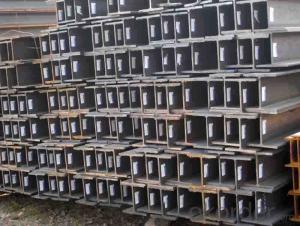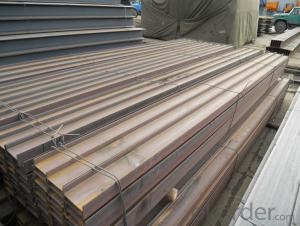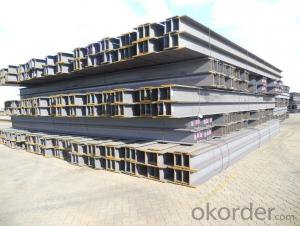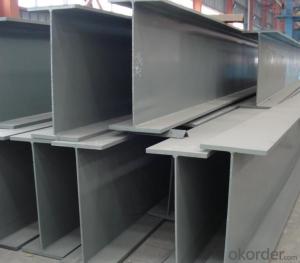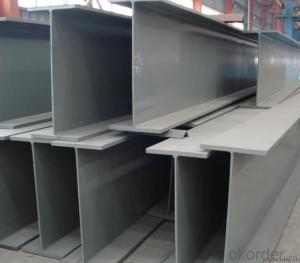Hot Rolled Steel H Beam SS400 with high quality
- Loading Port:
- Tianjin
- Payment Terms:
- TT or LC
- Min Order Qty:
- 25 m.t.
- Supply Capability:
- 100000 m.t./month
OKorder Service Pledge
OKorder Financial Service
You Might Also Like
Product Description:
OKorder is offering Hot Rolled Steel H Beam SS400 with high qualityat great prices with worldwide shipping. Our supplier is a world-class manufacturer of steel, with our products utilized the world over. OKorder annually supplies products to European, North American and Asian markets. We provide quotations within 24 hours of receiving an inquiry and guarantee competitive prices.
Product Applications:
Hot Rolled Steel H Beam SS400 with high quality are ideal for structural applications and are widely used in the construction of buildings and bridges, and the manufacturing, petrochemical, and transportation industries.
Product Advantages:
OKorder's Hot Rolled Steel H Beam SS400 with high quality are durable, strong, and resist corrosion.
Main Product Features:
· Premium quality
· Prompt delivery & seaworthy packing (30 days after receiving deposit)
· Corrosion resistance
· Can be recycled and reused
· Mill test certification
· Professional Service
· Competitive pricing
Product Description:
Specifications of Hot Rolled Structural Steel H Beam
1. Standard: GB700-88, Q235B2.
2. Grade: Q235, SS400 or Equivalent
3. Length: 6m,10m, 12m as following table
4. Invoicing on theoretical weight or actual weight as customer request
5.Payment: TT or L/C
Usage & Applications of Hot Rolled Structural Steel H Beam
Commercial building structure ;Pre-engineered buildings; Machinery support structure; Prefabricated structure; Medium scale bridges; Ship-building structure. etc.
Packaging & Delivery of Hot Rolled Structural Steel H Beam
1. Packing: it is nude packed in bundles by steel wire rod
2. Bundle weight: not more than 3.5MT for bulk vessel; less than 3 MT for container load
3. Marks:
Color marking: There will be color marking on both end of the bundle for the cargo delivered by bulk vessel. That makes it easily to distinguish at the destination port.
Tag mark: there will be tag mark tied up on the bundles. The information usually including supplier logo and name, product name, made in China, shipping marks and other information request by the customer.
If loading by container the marking is not needed, but we will prepare it as customer request.
4. Transportation: the goods are delivered by truck from mill to loading port, the maximum quantity can be loaded is around 40MTs by each truck. If the order quantity cannot reach the full truck loaded, the transportation cost per ton will be little higher than full load.
5. Delivered by container or bulk vessel
Production flow of Hot Rolled Structural Steel H Beam
Material prepare (billet) —heat up—rough rolling—precision rolling—cooling—packing—storage and transportation
FAQ:
Q1: Why buy Materials & Equipment from OKorder.com?
A1: All products offered byOKorder.com are carefully selected from China's most reliable manufacturing enterprises. Through its ISO certifications, OKorder.com adheres to the highest standards and a commitment to supply chain safety and customer satisfaction.
Q2: Can fit in the containers of 20fts the steel beams of 6M?
A2: No proble, we can put them into the containers in the form sideling.
Q3: The products are invoicing on theoritical weight or on actual weight?
A3: We can do it in both manners, according to the customers' request.
Images:
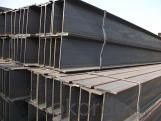
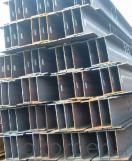
- Q:What are the different methods of protecting steel H-beams from corrosion?
- There are several methods of protecting steel H-beams from corrosion. One common method is applying a protective coating such as paint or epoxy. This creates a barrier between the steel and the corrosive elements in the environment. Another method is galvanizing, where a layer of zinc is applied to the steel through a process called hot-dip galvanizing. This zinc coating acts as a sacrificial layer, corroding before the steel does. Additionally, using stainless steel H-beams can provide inherent corrosion resistance due to their composition. Regular maintenance and inspection to identify and address any signs of corrosion is also crucial in protecting steel H-beams from corrosion.
- Q:Can steel H-beams be used for gymnasiums?
- Yes, steel H-beams can be used for gymnasiums. Steel H-beams are commonly used in construction due to their high strength and durability. They provide structural support and can withstand heavy loads, making them suitable for gymnasiums that require large open spaces and have high ceilings. Additionally, steel H-beams allow for flexible and customizable designs, making them a popular choice for gymnasium structures.
- Q:Can steel H-beams be used in marine or coastal environments?
- Yes, steel H-beams can be used in marine or coastal environments, but they require special coatings and maintenance to prevent corrosion. Steel H-beams are commonly used in the construction of marine structures, such as piers, docks, and offshore platforms, due to their strength and durability. However, exposure to saltwater and moisture can lead to accelerated corrosion of the steel beams. To mitigate this, the beams need to be properly coated with corrosion-resistant materials, such as epoxy or galvanized coatings. Additionally, regular inspection and maintenance are crucial to identify and address any signs of corrosion or damage. Failure to maintain the beams in a marine environment can significantly reduce their lifespan and compromise the structural integrity of the marine structure.
- Q:Can Steel H-Beams be used in agricultural or industrial buildings?
- Yes, Steel H-Beams can be used in both agricultural and industrial buildings. Due to their high strength-to-weight ratio and durability, H-Beams are commonly utilized in constructing structures that require a strong and stable framework, such as warehouses, barns, factories, and other industrial facilities. The versatile nature of H-Beams makes them suitable for withstanding heavy loads and providing structural support in these types of buildings.
- Q:How do steel H-beams perform in terms of buckling resistance?
- Steel H-beams are renowned for their exceptional ability to resist buckling. This is due to the H-shape, which gives the beam a higher moment of inertia, thereby reducing the likelihood of buckling when subjected to compressive loads. The flanges of the H-beam play a vital role in distributing the load evenly, minimizing the risk of localized buckling. Moreover, the vertical web of the H-beam adds extra rigidity, further increasing its resistance to buckling. Considering these factors, steel H-beams are widely regarded as one of the most durable and dependable structural components, making them exceptionally suitable for applications where buckling resistance is of utmost importance.
- Q:How do steel H-beams perform in terms of torsion resistance?
- Steel H-beams have excellent torsion resistance due to their shape and design. The horizontal flanges and vertical web provide high strength and stability against twisting forces, making them ideal for applications requiring resistance to torsion.
- Q:What are the different types of steel coatings available for H-beams?
- There are several different types of steel coatings available for H-beams, each with its own unique properties and advantages. 1. Galvanized Coating: This is one of the most commonly used coatings for H-beams. Galvanized coating involves applying a layer of zinc to the surface of the steel through a process called hot-dip galvanizing. This coating provides excellent corrosion resistance, making it ideal for applications where the H-beams are exposed to moisture or harsh environments. 2. Epoxy Coating: Epoxy coatings are frequently used when extra protection against corrosion is required. These coatings consist of a two-part epoxy resin that is applied to the surface of the steel. Epoxy coatings are highly resistant to chemicals, moisture, and abrasion, making them suitable for various industrial applications. 3. Powder Coating: Powder coating involves applying a dry powder to the surface of the H-beams, which is then heated and cured to form a protective layer. This coating provides excellent resistance to scratches, chipping, and fading, making it commonly used in architectural applications where aesthetics are important. 4. Thermal Spray Coating: Thermal spray coatings involve applying a layer of molten or softened material onto the surface of the steel. This process creates a durable coating that provides excellent resistance to corrosion, wear, and high temperatures. Thermal spray coatings are commonly used in industries such as oil and gas, aerospace, and automotive. 5. Organic Coating: Organic coatings, such as acrylic or polyurethane, are often used when a more decorative or aesthetic finish is desired. These coatings provide a high-gloss finish and come in a variety of colors. While they may not offer the same level of corrosion resistance as other coatings, they are still suitable for certain applications where appearance is a primary concern. It is important to consider the specific requirements of your project when choosing a steel coating for H-beams. Factors such as environmental conditions, intended use, and budget will all play a role in determining the most suitable coating option. Consulting with a steel coating expert or engineer can help ensure the best coating is chosen for your specific needs.
- Q:How are steel H-beams installed on construction sites?
- Steel H-beams are widely utilized in construction sites due to their strength and durability. To ensure their proper placement and stability, a series of steps are involved in the installation process. To begin with, the installation of steel H-beams necessitates the preparation of the construction site. This involves tasks such as clearing debris, leveling the ground, and verifying the foundation's ability to bear the weight of the beams. Once the site is prepared, the steel H-beams are typically delivered in sections. These sections are then hoisted into position utilizing cranes or other heavy machinery. Careful alignment and placement on temporary supports, known as cribbing, are conducted to keep the beams in place during installation. Subsequently, the beams are fastened together at the connection points, ensuring the formation of a solid and secure structure. Additional reinforcement may be achieved through welding to enhance the strength of the connections. Following the connection process, hydraulic jacks or other lifting equipment are employed to adjust the beams into the desired position. This guarantees that the beams are level and properly aligned with the rest of the structure. Once the beams are in their final position, they are permanently secured to the foundation or supporting structure using bolts or welding. This ensures their stability and prevents any potential shifting or movement over time. Lastly, the temporary supports, or cribbing, can be removed once the beams are firmly in place. This allows for the completion of other construction tasks, such as the installation of flooring or walls. In conclusion, the installation of steel H-beams on construction sites necessitates meticulous planning, coordination, and the utilization of suitable machinery. Adhering to industry guidelines and standards is crucial to ensure the structural integrity and safety of the building.
- Q:What is the purpose of using H-beams?
- H-beams, also known as I-beams or universal beams, have a crucial role in the construction industry. They serve to provide structural support and strength to different types of structures, including buildings, bridges, and other infrastructure projects. The distinctive shape of H-beams, resembling the letter "H" when viewed from the cross-section, is one of their key advantages. This design enables H-beams to distribute weight evenly and effectively, making them ideal for carrying heavy loads and resisting bending or deflection. The top and bottom flanges of the beam offer resistance against compressive and tensile forces, while the web in between ensures stability and prevents buckling. The purpose of using H-beams is to establish a stable and durable framework for various structures, ensuring their longevity and safety. They are frequently used in the construction of high-rise buildings, as they can support significant vertical loads, such as the weight of multiple floors, walls, and equipment. In bridge construction, H-beams are commonly utilized due to their strength and load-bearing capacity being crucial. Engineers can design bridges capable of withstanding heavy traffic loads and environmental forces by employing H-beams, thereby ensuring the safety and functionality of these critical transportation structures. Furthermore, H-beams find applications in industrial structures, such as warehouses and factories, where they provide necessary support for heavy machinery, cranes, and storage systems. The robustness and stability of H-beams make them an excellent choice for such applications, guaranteeing the integrity and functionality of the structures. In summary, the purpose behind using H-beams is to provide structural support and strength to various construction projects, including buildings, bridges, and industrial structures. Their unique shape and design allow for efficient weight distribution, resistance against bending, and overall stability. As a result, they have become an indispensable component in modern construction practices.
- Q:How is the weight of H steel calculated?
- The formula for calculating the load-bearing capacity of H steel is as follows:M = [(H 2×2×T1 + T2)××××0.858 T2 + R / R)×1000×7.85
1. Manufacturer Overview |
|
|---|---|
| Location | |
| Year Established | |
| Annual Output Value | |
| Main Markets | |
| Company Certifications | |
2. Manufacturer Certificates |
|
|---|---|
| a) Certification Name | |
| Range | |
| Reference | |
| Validity Period | |
3. Manufacturer Capability |
|
|---|---|
| a)Trade Capacity | |
| Nearest Port | |
| Export Percentage | |
| No.of Employees in Trade Department | |
| Language Spoken: | |
| b)Factory Information | |
| Factory Size: | |
| No. of Production Lines | |
| Contract Manufacturing | |
| Product Price Range | |
Send your message to us
Hot Rolled Steel H Beam SS400 with high quality
- Loading Port:
- Tianjin
- Payment Terms:
- TT or LC
- Min Order Qty:
- 25 m.t.
- Supply Capability:
- 100000 m.t./month
OKorder Service Pledge
OKorder Financial Service
Similar products
New products
Hot products
Related keywords
